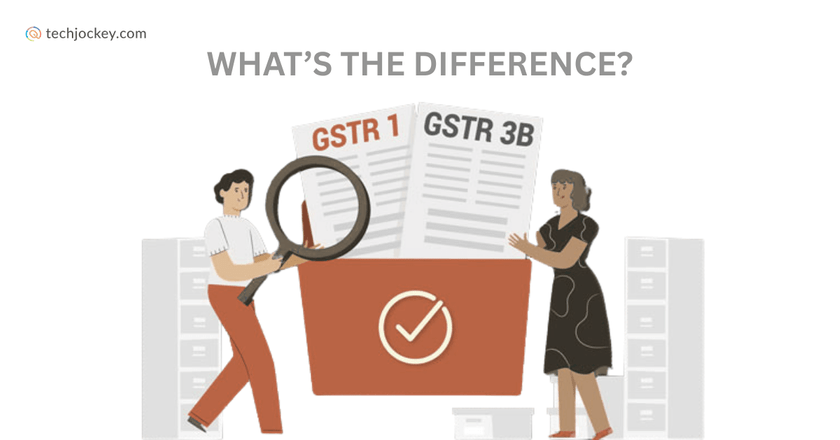Compliance with GST returns is one of the most important monthly exercises for businesses in India. It thus comes as no surprise that many find it confusing to understand the nuances of different returns, especially GSTR-1 and GSTR-3B. The extent is so that nearly 40% of the errors and penalties imposed by GST authorities stem from irregularities in these two returns.
If you are a business owner, understanding the difference between GSTR-1 and 3B is therefore not just a compliance requirement for you but crucial to your business’s smooth financial operation. Let’s get into the distinctions then, shall we?
What are GSTR 1 and GSTR 3B?
Understanding the basics of GST returns starts with knowing what these two key forms represent. GSTR-1 is a return that deals specifically with your outward supplies, or in simple terms, your sales. It is a detailed report filed by registered taxpayers to declare every invoice raised during a tax period. Many businesses now rely on GST software to automate this process
This means you must list…
- Invoice numbers and dates
- Types of customers, like B2B or B2C
- Taxable value and GST rates applied
- Details of goods and services supplied
This detailed filing makes GSTR-1 an elaborate ledger of all your sales transactions. Why does this matter? Because your customers rely on the accuracy of your GSTR-1 data to claim their input tax credit (ITC). This is exactly how this return ensures transparency and the correct flow of tax credits in the supply chain.
GSTR-1, as such, has to be filed monthly by companies with an annual turnover exceeding INR 1.5 crore, and quarterly by companies with a turnover less than that. The filing must be made promptly and effectively wherever possible in order to have a healthy credit flow.
In contrast, GSTR-3B is a simple, monthly self-declaration form. It serves as an overview of all your outward supplies (sales), inward supplies that are subject to reverse charge, ITC claimed, and your tax payment details.
Unlike GSTR-1, GSTR-3B does not need invoice-wise details. It instead requests aggregate sales, purchases, and tax liability numbers. It is the return where you actually pay your GST dues for the month.
All regular taxpayers must file GSTR-3B every month, regardless of turnover, making it the fastest way for GST authorities to collect taxes and track monthly liabilities.
Comparison Between GSTR 1 and GSTR 3B
| Particulars | GSTR-1 | GSTR-3B |
|---|---|---|
| Definition | Return for reporting outward supplies (sales) invoice-wise | Summary return for declaring GST liability and claiming ITC |
| Nature of Information | Detailed, invoice-level disclosure of sales, debit and credit notes | Aggregate figures of sales, purchases, ITC, and tax payable |
| Filing Frequency | Monthly (if turnover > ₹1.5 Cr) or Quarterly (if turnover ≤ ₹1.5 Cr) | Monthly for all regular taxpayers |
| Purpose | Verification of sales invoices and ITC for buyers and authorities | Used mainly for tax payment and ITC utilization |
| Tax Payment | No tax payment; only reporting sales data | Actual GST payment is made through this return |
| Due Date | 11th of next month (monthly) / 28th of next month after quarter (quarterly) | 20th of the following month |
| Consequences of Non-Compliance | Mismatch may block buyer’s ITC; late filing invites penalties | Late filing attracts penalty and interest; mismatches may trigger notices |
| Impact on ITC | Directly impacts buyer’s ITC claim as invoices are matched | Shows ITC utilization but does not provide buyer-wise details |
What is the Difference Between GSTR 1 and GSTR 3B?
Both GSTR-1 and 3B are associated with the same tax period, but they have different purposes to serve. The difference between GSTR-1 and GSTR-3B lies in the following areas, understanding which will help you file returns more accurately.
1. Nature of Information
GSTR-1 entails detailed, invoice-wise disclosure. This means every transaction, and credit or debit note raised, must be listed with precision. GSTR-3B contains aggregated figures. You declare totals, not individual invoice details.
2. Filing Frequency
GSTR-1 frequency depends on turnover. Big businesses (above INR 1.5 crore turnover) file monthly, while smaller ones file quarterly. GSTR-3B, conversely, is mandatory to be filed every month for all regular taxpayers.
3. Purpose & Use
Authorities and buyers use GSTR-1 for verification and ensuring ITC integrity. It’s a backend data source to cross-check your sales invoices. GSTR-3B, on the other hand, is primarily for tax payment. It ensures the timely remittance of your GST liability.
TallyPrime
4. Tax Payment
No tax payments are made through GSTR-1; it’s just reporting sales. GSTR-3B, however, is the vehicle for paying your monthly GST dues.
5. Deadline Differences
The filing date of GSTR-3B falls on the 20th of the following month. GSTR-1 due date, on the other hand, can either be the 11th or the 28th, depending on your turnover and taxpayer category.
6. Consequences of Non-Compliance
Misfiling or late filing of either of the forms can be an invitation to penalties. And mismatches between the two may cause audits or notices. Tax authorities match GSTR-1 data with that of 3B to find out where differences lie.
7. Impact on Input Tax Credit (ITC)
Buyers rely on GSTR-1 invoice data for claiming ITC. If your GSTR-1 is incorrect, their credit claims may be rejected. GSTR-3B affects the tax amount you pay, but doesn’t detail the buyer ITC directly.
Why Does the Difference Between GSTR-1 and GSTR-3B Matter?
In the real world, the gaps between reported sales and tax paid cause many headaches. For instance, if a taxpayer reports INR 50 lakhs of sales in GSTR-3B but only INR 45 lakhs in GSTR-1, discrepancies arise. These mismatches can…
- Delay your customers’ ITC claims, impacting their working capital
- Trigger GST department scrutiny and possible penalties
- Lead to the blocking of refunds or GST registrations in severe cases
Besides, as GST emerges as a more data-intensive tax system, the government is employing software and data analytics to identify inconsistencies between these two forms. For businesses, this means being careful about sales data and tax payments isn’t optional anymore; it’s a must.
Conclusion
India’s GST regime relies heavily on transparent and accurate filing of multiple returns, with GSTR-1 and 3B forming the compliance backbone.
ClearTax GST
The difference between GSTR-1 and 3B boils down to…
GSTR-1 is a detailed ledger of your outward supplies, essential for buyers to claim input tax credit.
GSTR-3B is a monthly summary return that declares your tax liability and facilitates payment.
Both forms should be submitted properly and in time. Any mismatch in them may negatively impact the compliance status, cash flow, and overall reputation of your business.
To master GSTR-1 and GSTR-3B filing, please refer to our blogs on
Yashika Aneja is a Senior Content Writer at Techjockey, with over 5 years of experience in content creation and management. From writing about normal everyday affairs to profound fact-based stories on wide-ranging themes, including environment, technology, education, politics, social media, travel, lifestyle so on and so forth, she... Read more









